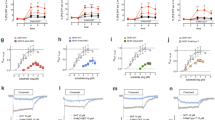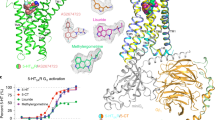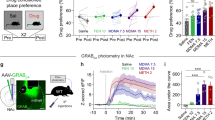Abstract
The role of serotonin 5-HT2 receptors (5-HT2R) in the hyperactivity induced by (+)-3,4-methylenedioxy-methamphetamine ((+)-MDMA; 3 mg/kg) was investigated. Hyperactivity induced by (+)-MDMA was robustly potentiated by the 5-HT2B/2CR antagonist SB 206553 (1.0, 2.0, and 4.0 mg/kg). Administration of the 5-HT1B/1DR antagonist GR 127935 (2.5 mg/kg) or the 5-HT2AR antagonist M100907 (1.0 mg/kg) partially suppressed the potentiated hyperactivity seen following SB 206553 plus (+)-MDMA; a blockade to activity levels seen with (+)-MDMA alone was observed following the combination of GR 127935 plus M100907. A modest potentiative interaction was seen when SB 206553 was combined with the DA releaser amphetamine (0.5 mg/kg) or amphetamine plus the 5-HT releaser fenfluramine (4.0 mg/kg). SB 206553 (1–4 mg/kg), GR 127935 (2.5 mg/kg) and M100907 (1 mg/kg) did not alter spontaneous activity upon administration singly or in combination. These data suggest that activation of 5-HT2CR exerts a strong inhibitory influence on the hyperactivity induced by (+)-MDMA, and that 5-HT2CR blockade unmasks hyperactivity mediated through several mechanisms.
Similar content being viewed by others
Log in or create a free account to read this content
Gain free access to this article, as well as selected content from this journal and more on nature.com
or
References
Aulakh CS, Hill JL, Wozniak KM, Murphy DL . (1988): Fenfluramine-induced suppression of food intake and locomotor activity is differentially altered by the selective type A monoamine oxidase inhibitor clorgyline. Psychopharmacology 95: 313–317
Bankson MG, Cunningham KA . (2001): 3,4-Methylenedioxymethamphetamine (MDMA) as a unique model of serotonin receptor function and serotonin-dopamine interactions. J Pharmacol Exp Ther 297: 846–852
Barnes NM, Sharp T . (1999): A review of central 5-HT receptors and their function. Neuropharmacology 38: 1083–1152
Battaglia G, Brooks BP, Kulsakdinun C, DeSouza EB . (1988): Pharmacologic profile of MDMA (3,4-methylenedioxymethamphetamine) at various brain recognition sites. Eur J Pharmacol 149: 159–163
Benloucif S, Keegan MJ, Galloway MP . (1993): Striatal infusion of serotonin, TFMPP, or m-CPP facilitate dopamine release in vivo. J Pharmacol Exp Ther 265: 373–377
Callahan PM, Cunningham KA . (1995): Modulation of the discriminative stimulus properties of cocaine by 5-HT1B and 5-HT2C receptors. J Pharmacol Exp Ther 274: 1414–1424
Callaway CW, Rempel N, Peng RY, Geyer MA . (1992): Serotonin 5–HT1-like receptors mediate hyperactivity in rats induced by 3,4-methylenedioxymethamphetamine. Neuropsychopharmacol 7: 113–127
Callaway CW, Wing LL, Geyer MA . (1990): Serotonin release contributes to the locomotor stimulant effects of 3,4- methylenedioxymethamphetamine in rats. J Pharmacol Exp Ther 254: 456–464
Callaway CW, Wing LL, Nichols DE, Geyer MA . (1993): Suppression of behavioral activity by norfenfluramine and related drugs in rats is not mediated by serotonin release. Psychopharmacology 111: 169–178
Clemett DA, Punhani T, Duxon MS, Blackburn TP, Fone KCF . (2000): Immunohistochemical localisation of the 5-HT2C receptor protein in the rat CNS. Neuropharmacology 39: 123–132
Crespi D, Mennini T, Gobbi M . (1997): Carrier-dependent and Ca(2+)-dependent 5-HT and dopamine release induced by (+)-amphetamine, 3,4-methylendioxymethampheta- mine, p- chloroamphetamine and (+)-fenfluramine. Br J Pharmacol 121: 1735–1743
Dewey SL, Chaurasia CS, Chen CE, Volkow ND, Clarkson FA, Porter SP, Straughter-Moore RM, Alexoff DL, Tedeschi D, Russo NB, Fowler JS, Brodie JD . (1997): GABAergic attenuation of cocaine-induced dopamine release and locomotor activity. Synapse 25: 393–398
Di Matteo V, Di Giovanni G, Di Mascio M, Esposito E . (1998): Selective blockade of serotonin2C/2B receptors enhances dopamine release in the rat nucleus accumbens. Neuropharmacology 37: 265–272
Di Matteo V, Di Giovanni G, Di Mascio M, Esposito E . (1999): SB 242084, a selective serotonin2C receptor antagonist, increases dopaminergic transmission in the mesolimbic system. Neuropharmacology 38: 1195–1205
Di Matteo V, Di Giovanni G, Di Mascio M, Esposito E . (2000): Biochemical and electrophysiological evidence that RO 60–0175 inhibits mesolimbic dopaminergic function through serotonin(2C) receptors. Brain Res 865: 85–90
Duxon MS, Kennett GA, Lightowler S, Blackburn TP, Fone KC . (1997): Activation of 5–HT2B receptors in the medial amygdala causes anxiolysis in the social interaction test in the rat. Neuropharmacology 36: 601–608
Eberle-Wang K, Mikeladze Z, Uryu K, Chesselet MF . (1997): Pattern of expression of the serotonin2C receptor messenger RNA in the basal ganglia of adult rats. J Comp Neurol 384: 233–247
Gleason SD, Shannon HE . (1998): Meta-chlorophenylpiperazine induced changes in locomotor activity are mediated by 5–HT1 as well as 5–HT2C receptors in mice. Eur J Pharmacol 341: 135–138
Gobert A, Rivet JM, Cistarelli L, Millan MJ . (1997): Potentiation of the fluoxetine-induced increase in dialysate levels of serotonin (5-HT) in the frontal cortex of freely moving rats by combined blockade of 5-HT1A and 5-HT1B receptors with WAY 100,635 and GR 127,935. J Neurochem 68: 1159–1163
Gold LH, Hubner CB, Koob GF . (1989): A role for the mesolimbic dopamine system in the psychostimulant actions of MDMA. Psychopharmacology 99: 40–47
Gold LH, Koob GF . (1988): Methysergide potentiates the hyperactivity produced by MDMA in rats. Pharmacol Biochem Behav 29: 645–648
Gold LH, Koob GF . (1989): MDMA produces stimulant-like conditioned locomotor activity. Psychopharmacology 99: 352–356
Greer G, Tolbert R . (1986): Subjective reports of the effects of MDMA in a clinical setting. J Psychoactive Drugs 18: 319–327
Grottick AJ, Fletcher PJ, Higgins GA . (2000): Studies to investigate the role of 5–HT2C receptors on cocaine- and food-maintained behavior. J Pharmacol Exp Ther 295: 1183–1191
Gudelsky GA, Nash JF . (1996): Carrier-mediated release of serotonin by 3,4- methylenedioxymethamphetamine: implications for serotonin-dopamine interactions. J Neurochem 66: 243–249
Heisler LK and Tecott LH . (2000): A paradoxical locomotor response in serotonin 5-HT(2C) receptor mutant mice. J Neurosci (Online) 20: RC71
Hernandez L, Lee F, Hoebel BG . (1987): Simultaneous microdialysis and amphetamine infusion in the nucleus accumbens and striatum of freely moving rats: increase in extracellular dopamine and serotonin. Brain ResBull 19: 623–628
Kehne JH, Ketteler HJ, McCloskey TC, Sullivan CK, Dudley MW, Schmidt CJ . (1996): Effects of the selective 5–HT2A receptor antagonist MDL 100,907 on MDMA-induced locomotor stimulation in rats. Neuropsychopharmacol 15: 116–124
Kelly PH, Seviour PW, Iversen SD . (1975): Amphetamine and apomorphine responses in the rat following 6-OHDA lesions of the nucleus accumbens septi and corpus striatum. Brain Res 94: 507–522
Kennett GA, Curzon G . (1988): Evidence that hypophagia induced by mCPP and TFMPP requires 5–HT1C and 5–HT1B receptors; hypophagia induced by RU 24969 only requires 5–HT1B receptors. Psychopharmacology 96: 93–100
Kennett GA, Wood MD, Bright F, Cilia J, Piper DC, Gager J, Thomas D, Baxter GS, Forbes IT, Ham P, Blackburn TP . (1996): In vitro and in vivo profile of SB 206553, a potent 5–HT2C/5–HT2B receptor antagonist with anxiolytic-like properties. Br J Pharmacol 117: 427–434
Keppel G . (1973): Design and Analysis: A Researcher's Handbook. Englewood Cliffs, NJ. Prentice-Hall, Inc.
Koch S, Galloway MP . (1997): MDMA induced dopamine release in vivo: role of endogenous serotonin. J Neural Transm 104: 135–146
Lucas G, De Deurwaerdere P, Caccia S, Umberto S . (2000): The effect of serotonergic agents on haloperidol-induced striatal dopamine release in vivo: opposite role of 5-HT(2A) and 5-HT(2C) receptor subtypes and significance of the haloperidol dose used. Neuropharmacology 39: 1053–1063
Lucas G, Spampinato U . (2000): Role of striatal 5–HT2A and 5–HT2C receptor subtypes in the control of in vivo dopamine outflow in the rat striatum. J Neurochem 74: 693–701
McCreary AC, Bankson MG, Cunningham KA . (1999): Pharmacological studies of the acute and chronic effects of (+)-3, 4- methylenedioxymethamphetamine on locomotor activity: role of 5-HT1A and 5-HT1B/1D receptors. J Pharmacol Exp Ther 290: 965–973
McCreary AC, Cunningham KA . (1999): Effects of the 5–HT2C/2B antagonist SB 206553 on hyperactivity induced by cocaine. Neuropsychopharmacol 20: 556–564
McMahon LR, Cunningham KA . (2001a): Role of 5-HT2A and 5-HT2B/2C receptors in the potentiative behavioral interactions between serotonin and catecholamine reuptake inhibitors. Neuropsychopharmacol 24: 319–329
McMahon LR, Cunningham KA . (2001b): Antagonism of 5-hydroxytryptamine2A receptors attenuates the behavioral effects of cocaine in rats. J Pharmacol Exper Ther 297: 357–363
Nash JF . (1990): Ketanserin pretreatment attenuates MDMA-induced dopamine release in the striatum as measured by in vivo microdialysis. Life Sci 47: 2401–2408
Ng NK, Lee HS, Wong PT . (1999): Regulation of striatal dopamine release through 5–HT1 and 5–HT2 receptors. J Neurosci Res 55: 600–607
O'Neill MF, Fernández AG, Palacios JM . (1996): GR 127935 blocks the locomotor and antidepressant-like effects of RU 24969 and the action of antidepressants in the mouse tail suspension test. Pharmacol Biochem Behav 53: 535–539
Parsons LH, Koob GF, Weiss F . (1999): RU 24969, a 5-HT1B/1A receptor agonist, potentiates cocaine-induced increases in nucleus accumbens dopamine. Synapse 32: 132–135
Paulus MP, Geyer MA . (1992): The effects of MDMA and other methylenedioxy-substituted phenylalkylamines on the structure of rat locomotor activity. Neuropsychopharmacol 7: 15–31
Pompeiano M, Palacios JM, Mengod G . (1994): Distribution of the serotonin 5-HT2 receptor family mRNAs: Comparison between 5-HT2A and 5-HT2C receptors. Mol Brain Res 23: 163–178
Rempel NL, Callaway CW, Geyer MA . (1993): Serotonin1B receptor activation mimics behavioral effects of presynaptic serotonin release. Neuropsychopharmacol 8: 201–211
Robledo P, Maldonado-Lopez R, Koob GF . (1992): Role of dopamine receptors in the nucleus accumbens in the rewarding properties of cocaine. Ann NY Acad Sci 654: 509–512
Rudnick G, Wall SC . (1992): The molecular mechanism of “ecstasy” (3,4-methylenedioxy- methamphetamine (MDMA)): serotonin transporters are targets for MDMA- induced serotonin release. Proc Natl Acad Sci USA 89: 1817–1821
Schmidt CJ, Sullivan CK, Fadayel GM . (1994): Blockade of striatal 5-HT2 receptors reduces the increase in extracellular concentrations of dopamine produced by the amphetamine analogue 3,4-methylenedioxymethamphetamine. J Neurochem 62: 1382–1389
Sorensen SM, Kehne JH, Fadayel GM, Humphreys TM, Ketteler HJ, Sullivan CK, Taylor VL, Schmidt CJ . (1993): Characterization of the 5-HT2 receptor antagonist MDL 100907 as a putative atypical antipsychotic: Behavioral, electrophysiological and neurochemical studies. J Pharmacol Exp Ther 266: 684–691
Spanos LJ, Yamamoto BK . (1989): Acute and subchronic effects of methylenedioxymethamphetamine ((+/-)-MDMA) on locomotion and serotonin syndrome behavior in the rat. Pharmacol Biochem Behav 32: 835–840
Trulson ME, Jacobs BL . (1976): Behavioral evidence for the rapid release of CNS serotonin by PCA and fenfluramine. Eur J Pharmacol 36: 149–154
Viana MB, Silveira R, Graeff FG . (1996): D-fenfluramine selectively releases 5-HT from dorsal raphe terminals. Braz J Med Biol Res 29: 639–642
White SR, Duffy P, Kalivas PW . (1994): Methylenedioxymethamphetamine depresses glutamate-evoked neuronal firing and increases extracellular levels of dopamine and serotonin in the nucleus accumbens in vivo. Neuroscience 62: 41–50
Wise RA, Bozarth MA . (1985): Brain mechanisms of drug reward and euphoria. Psychiatr Med 3: 445–460
Yamamoto BK, Nash JF, Gudelsky GA . (1995): Modulation of methylenedioxymethamphetamine-induced striatal dopamine release by the interaction between serotonin and gamma-aminobutyric acid in the substantia nigra. J Pharmacol Exp Ther 273: 1063–1070
Yamamoto BK, Spanos LJ . (1988): The acute effects of methylenedioxymethamphetamine on dopamine release in the awake-behaving rat. Eur J Pharmacol 148: 195–203
Acknowledgements
We would like to thank Billy Doyon for his technical assistance in completing this work. The research was supported by the National Institute on Drug Abuse grants DA 006511, DA 00260 and DA 07287. This manuscript was presented by M.G.B. in partial fulfillment of the requirements for the Ph.D. degree to the Graduate School of Biomedical Sciences at the University of Texas Medical Branch. Portions of this work were presented at the annual meeting of The College on Problems of Drug Dependence held in San Juan, Puerto Rico, in June, 2000.
Author information
Authors and Affiliations
Corresponding author
Rights and permissions
About this article
Cite this article
Bankson, M., Cunningham, K. Pharmacological Studies of the Acute Effects of (+)-3,4-Methylenedioxymethamphetamine on Locomotor Activity: Role of 5-HT1B/1D and 5-HT2 Receptors. Neuropsychopharmacol 26, 40–52 (2002). https://doi.org/10.1016/S0893-133X(01)00345-1
Received:
Revised:
Accepted:
Published:
Issue date:
DOI: https://doi.org/10.1016/S0893-133X(01)00345-1
Keywords
This article is cited by
-
A short history of the 5-HT2C receptor: from the choroid plexus to depression, obesity and addiction treatment
Psychopharmacology (2017)
-
Acute concomitant effects of MDMA binge dosing on extracellular 5-HT, locomotion and body temperature and the long-term effect on novel object discrimination in rats
Psychopharmacology (2011)
-
Caffeine promotes dopamine D1 receptor-mediated body temperature, heart rate and behavioural responses to MDMA (‘ecstasy’)
Psychopharmacology (2010)
-
Role of dopamine transporters in the behavioral effects of 3,4-methylenedioxymethamphetamine (MDMA) in nonhuman primates
Psychopharmacology (2009)
-
Serotonergic lesions of the dorsal hippocampus differentially modulate locomotor hyperactivity induced by drugs of abuse in rats: implications for schizophrenia
Psychopharmacology (2009)



